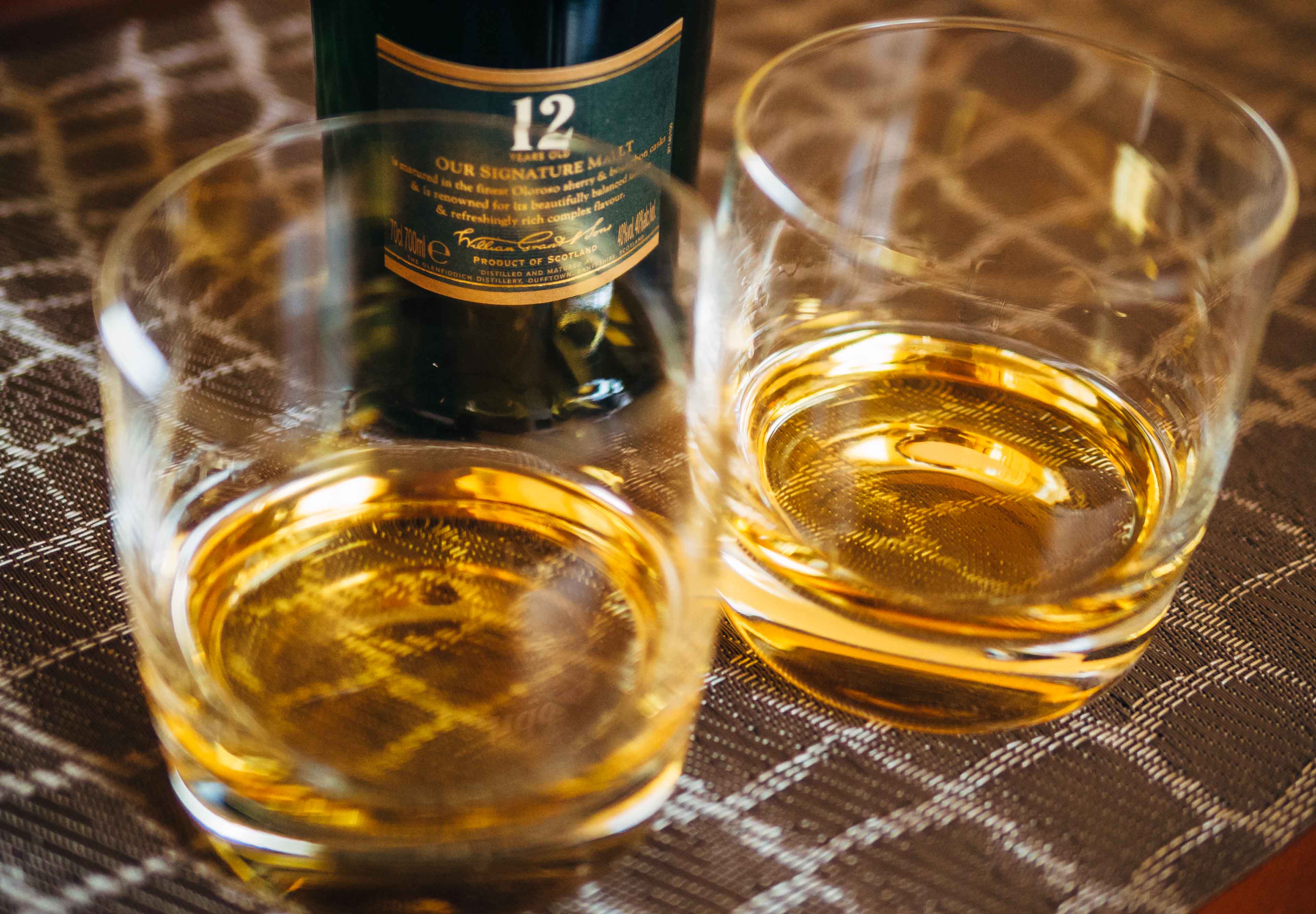It is a fact of life that over the years, as we mature and soak in more of the world, our tastes and preferences evolve with us. It is also a fact that certain things require some preparation before they can be enjoyed. You can’t just jump ahead and try them; you must be patient and trust that one day, when you’re ready, they will find you. Alcohol is one such thing, and it’s a journey that lasts a lifetime.
I’ve always wanted to venture into the world of single malt Scotch whisky and after years of waiting, I think it may finally be the right time for me.
This is the story of how I plan to do just that.
A bit of background
I distinctly remember the first time I tasted beer. I was very little — it was merely a small sip from my father’s glass — but I can still perfectly recall how utterly disgusted I was at that golden fluid; how incredibly bitter and horrible it was. At my young age, I didn’t understand how adults could drink the stuff, and how they could even claim to love it. Surely they must all be pretending just to look cool, I figured.
Skip forward a few years and boy, how things can change. It wasn’t until I started college — the legal drinking age in Spain is 18 — that I rediscovered beer and learned to appreciate it in a whole new way. I was skeptical at first, surely the remnants of my less-than-ideal first brush with it, but among new friends I quickly realized the error of my ways. College will do that to you, I suppose.
Wine took a little longer but it, too, seduced me at one point. An empty apartment, a blushing girl, an interesting conversation that seeped late into the night and suddenly — dance like nobody’s watching — wine tasted like hope. It tasted like the promise of better things, if only I had the courage to reach out for them. First red and then white, the love affair that started that night is still alive and well today, with no sign of abating.
Then there was the heavier stuff. Distilled spirits — mainly vodka, rum, gin and whisky — were very popular among my college friends, usually in combination with some sort of soda. Vodka with orange soda — a very poor interpretation of the classic Screwdriver) — was my poison of choice when I first started drinking socially and going out at night. Then I experimented with the usual suspects: gin and lemon soda, gin and tonic, and rum and coke were all thoroughly enjoyed among laughs, jokes and perhaps one too many hangovers.
You could say I’ve tried my fair share of drinks but in all that time, whisky always failed to capture my interest in a meaningful way. It wasn’t for lack of trying, either. Sometimes I would try one of the cheaper brands mixed with coke, or some fancier labels, neat or on the rocks. They were all perfectly adequate, but I was never quite able to really enjoy them, and given the choice I would always rather drink something else. I just wasn’t ready for it. Yet.
More recently, though, I have slowly discovered an inclination for simpler, stronger flavors. I like to taste the gin in my gin and tonic, for example, and I find myself leaning towards a Dry Martini — with little to no vermouth in it — whenever the situation requires some measure of sophistication. These are more mature drinks, often associated with older people. I guess I must be growing up, after all.
In light of the recent and profound changes in my life, it occurs to me that I may finally be ready to graduate to whisky. Single malt Scotch whisky, to be precise. In the words of Hunter S. Thompson: “anything worth doing, is worth doing right.”
The world of single malt Scotch whisky is deeply fascinating, full of heritage and sophistication. It takes a really long time — usually between 12 and 50 years, sometimes even longer — to produce a fine single malt and after centuries of trying, every single aspect of the distillation process has been refined to perfection by the master distillers of Scotland. Successfully entering this world is no small task, and will require a fair amount of research and patience.
A brief introduction to Scotch whisky
DISCLAIMER: Although this section is meant only as a starting point, it should be readily apparent that I’m by no means an expert on the subject. If you spot any inaccuracies, omissions or glaring mistakes, please let me know.
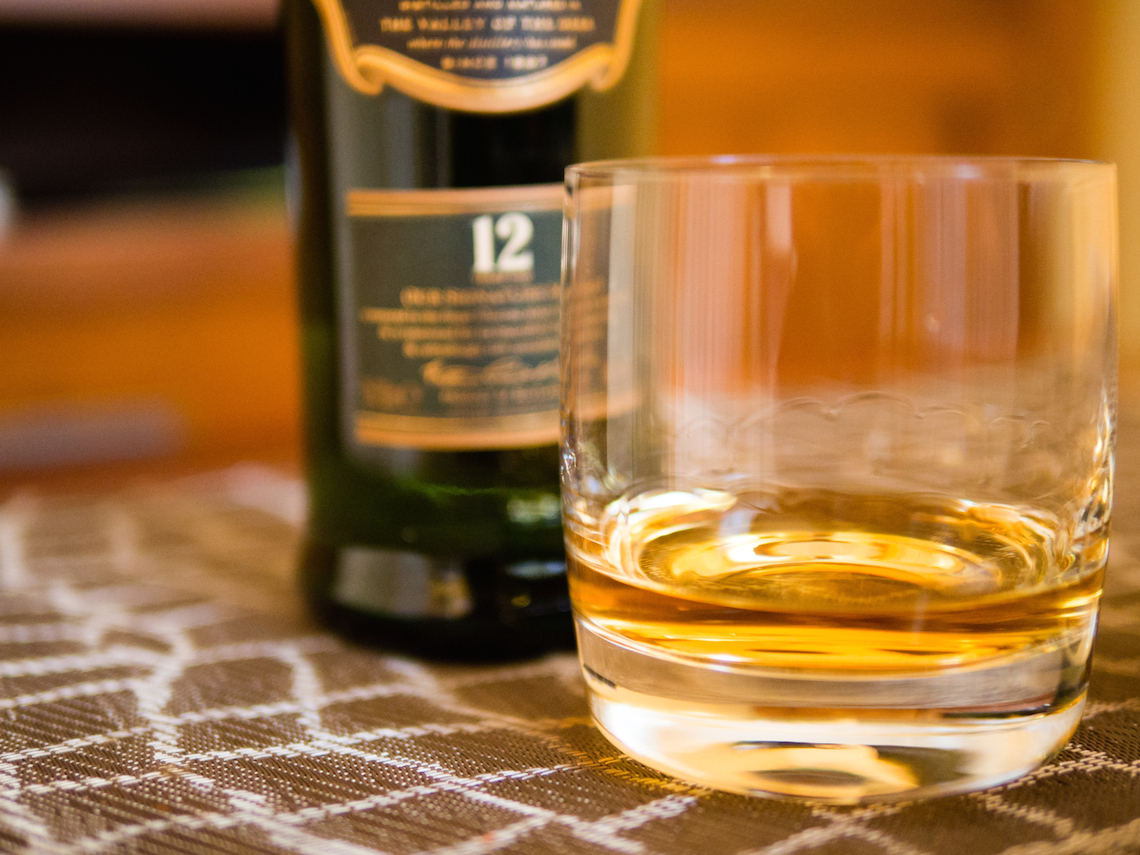
Whisky is a distilled alcoholic beverage made from fermented grain mash, usually malted barley, although other grains may be used. For a whisky to be labeled as Scotch whisky it must be produced entirely in Scotland and aged in oak casks for a minimum of 3 years prior to bottling. Finally, a single malt Scotch whisky must be made only from water and malted barley, and must be produced in a single distillery in Scotland.
Of course, there are other types of Scotch whisky, besides single malts. A single grain Scotch whisky is made from several grains but, as in the case of single malts, it’s still produced in a single distillery. Then there are blended malt Scotch whiskies, which are made from two or more single malts from different distilleries. Similarly, blended grain Scotch whiskies are made from several single grains from different distilleries. Finally, a blended Scotch whisky — which represents about 90% of the total production of Scotch whisky — is made from several single malt and single grain whiskies from different distilleries.
In reality, most whiskies are blended from different vats1 — even single malts are technically blended, although more restrictively so than the others. This is done by the brands to achieve a consistent product across different bottlings, and to ensure an experience that matches the brand’s usual profile. The question of age, then, requires some clarification: if a bottle of Scotch whisky displays a numeric age, the number must reference the age of the youngest whisky used to produce that blend. That is, a bottle of 12 year old single malt Scotch whisky may contain a blend of several single malt whiskies, all of which must be at least 12 years old.
Single malts belong to the most restrictive type of Scotch whisky.2 Because every aspect of the distillation process affects the final result, each single malt has distinct properties, which are a product of the unique environment in which it was created: the temperature, humidity, the water, the location of the distillery… even the placement of the casks within the warehouse! It’s an incredibly meticulous process and every distillery has its own heavily-guarded secrets.
Although no two single malts are exactly alike, some similarities can be found between single malts that are produced within the same region. Based on its geographical characteristics, Scotland can be divided in 5 whisky-producing regions:3
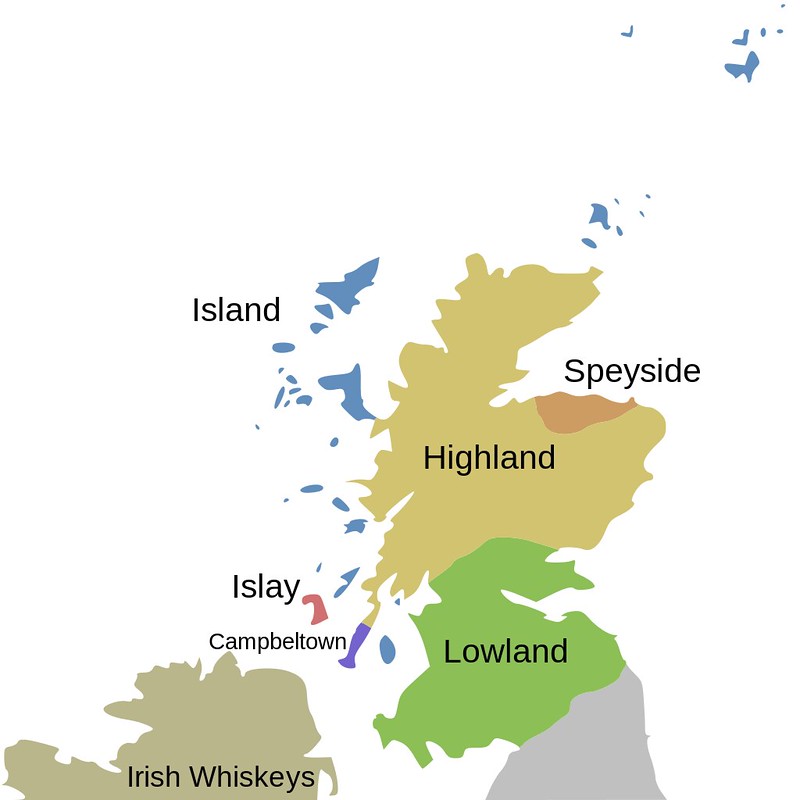
Highland is the largest distilling region, producing a wide range of whiskies which are usually very robust and with a sweet finish, though not as balanced as the Speyside single malts.
Speyside, though geographically part of the Highlands, has achieved recognition as an independent region due to its unique characteristics. The region received its name from the river Spey, and it has the greatest concentration of distilleries in all of Scotland, including the two best-selling single malts in the world: The Glenlivet and Glenfiddich. Speyside single malts are usually rich and well-balanced, with sweet flavors and aromas.
Lowland is a flat region with no mountains. Single malts from this region are usually triple distilled, which gives them a lighter body.
Islay is the southernmost of Scotland’s western islands. This region is famous for the smoky character of its whiskies, with the exception of some offerings from the Bruichladdich distillery.
Campbeltown, located on the Kintyre peninsula, was once considered the “whisky capital of the world”. Unfortunately as of 2010, only three distilleries continue to operate there: Glen Scotia, Gengyle and Springbank.
Lastly, Island is a term that encompasses all of the single malts produced in the islands around the perimeter of the Scottish mainland, with the exception of Islay. The islands are technically not a separate region, and are considered instead as part of the Highlands. Some notable Island single malts include Jura (from the Isle of Jura), and Talisker (from the Isle of Skye).4
Given the complexity of the single malt landscape and the sheer amount of excellent offerings available, it’s essential to establish a well-defined methodology to proceed in my journey.
Tasting Methodology
This section describes the steps I will follow to ensure that all tests are performed in a controlled environment. You know, for science.
Frequency: Only one tasting per week. Alcohol should be consumed in moderation, particularly if you have diabetes. Also, tasting single malt whiskies can be a pretty expensive hobby.
Age Order: Most people recommend the younger single malts as more appropriate to start with. This makes a lot of sense, since younger whiskies are often easier to procure and won’t break the bank, therefore allowing you to get a feel for what a particular brand has to offer before committing to a more serious purchase. Besides, in the case of single malts older is not always better, as it turns out. Therefore, I will begin by testing single malts in the 10-12 year old range and go from there.
Region Order: Tasting will also be arranged by region, with comparable offerings from the same region being tasted together whenever possible. I will begin with the Speyside region, and leave the heavily peated single malts from Islay and the Islands for last.
Procedure: Tasting will preferably occur during the weekend, and always after a meal. It will include a single serving only — technically, a dram — of each denomination being tasted. Each dram will be compared with its tasting notes from two different online sources: Master of Malt and All Things Whisky, as well as the official tasting notes advertised by the brand whenever possible. Initially I will focus on identifying the aspects highlighted in the tasting notes, to the best of my ability. Once I’ve built up my confidence and developed a personal preference, I will begin elaborating tasting notes of my own, and comparing them with the references cited above. When comparing two whiskies, I will taste one dram of each, together. In this case, a blind tasting will also occur whenever possible.
Review: I will review each whisky focusing on its nose, palate, finish, and overall impression to the best of my ability. I will also try to provide an example of a situation where I would consider drinking this particular single malt, based on its character. For instance, some may be ideal to drink while hanging out at a bar with some friends, while others may be best enjoyed quietly at home, or after a hard day’s work.
Where to Begin?
As the Chinese Philosopher Laozi said, “a journey of a thousand miles begins with a single step”. Now that I’ve laid out my goals in broad strokes, it’s time to decide where to start.
Luckily, professional whisky writer Mark Bylok, author of the upcoming book The Whisky Cabinet, was kind enough to assist me in this critical first step. His recommendation — based on my current drinking preferences — was The Laddie Ten, a 10 year old Islay single malt from the Buichladdich distillery. Despite being an Islay Scotch whisky, The Laddie Ten is notorious for being un-peated, that is, without the smoky character so associated with its Islay siblings. I’m personally not a big fan of smoky flavors, so The Laddie Ten seemed like a perfect starter for me.
Unfortunately, The Laddie Ten is very difficult to procure these days. According to a Bruichladdich spokesperson, The Laddie Ten was a vintage bottling from 2001, which means that only the original bottling was produced, and when it sells out they won’t be able to make more. After years of increasing popularity, The Laddie Ten is now in extremely short supply, which makes it almost impossible to find anymore.
A second recommendation was the popular Glenfiddich 12 Year Old. This Speyside Scotch whisky is actually the world’s best selling single malt, and is recommended by many as an ideal starter whisky. Sounds good to me. In fact, I’ve already purchased my first bottle and so far we seem to be getting along pretty well.
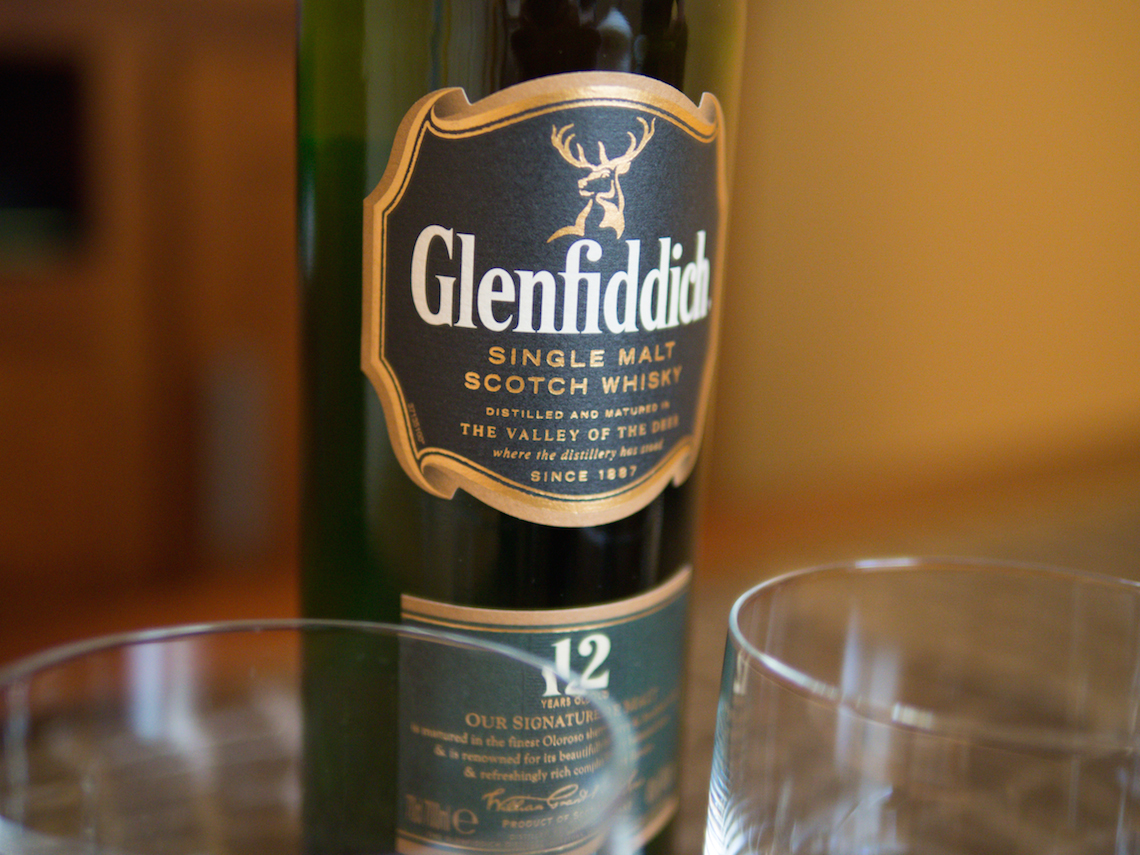
But that was only the beginning, of course. After a few more hours of research, this is what the first few stages of my travel itinerary looked like:
First there’s Glenfiddich 12, followed by a very similar Speyside single malt: The Glenlivet 12 Year Old. These two should make for a very interesting comparison.
Then, as per Mr. Matt Gemmell’s suggestion, I’ve included another Speyside single malt: Balvenie DoubleWood 12 Year Old.
The next single malt on my list really deserves a separate mention: The Macallan 10 Year Old Sherry Oak. Although geographically within the Speyside region, The Macallan labels their whiskies as Highland single malt Scotch whisky. That’s confusing, but if it’s as good as they say, they can name them however they want as far as I’m concerned. I may save this one for later because The Macallan is not a dram to be taken lightly.
Next up is Glenmorangie Original, a 10 year old Highland single malt that is also heralded as great for “breaking in the novice”. After that, another recommendation from Matt Gemmel: Glenmorangie Quinta Ruban 12 Year Old. And completing the Highland single malt lineup, another classic: Royal Lochnagar 12 Year Old.
From the Lowland region I will go with Glenkinchie 12 Year Old, which replaced the popular Glenkinchie 10 as their entry-level single malt in 2007.
From the Campbeltown region, I have chosen to go with Hazelburn 12 Year Old, which seems to be less overpowering than its siblings from Springbank and Longrow.
The next step will be the Bruichladdich Scottish Barley, an un-peated Islay single malt with no age denomination, which is meant to be the substitute of the almost-extinct Laddie Ten. And for a more typical Islay denomination, Laphroaig 10 Year Old should be a good choice.
After that and rounding up the younger single malts, two classics: Talisker 10 Year Old and Isle of Jura 10 year Old, both Island single malts. I actually tried the Talisker a few years ago, and I remember it being quite smoky, which was not at all to my taste at the time. In fact, I’ll probably be saving the Laphroaig and the Talisker for last.
All in all, I have selected 13 young single malt whiskies from all regions, which should provide a decent — albeit, still limited — overview of their different characteristics and personalities. Luckily for my wallet, the fine folks over at Master of Malt stock all of these, and sell them by the dram. That means I can order one or two drams of each without going broke.
Once I’ve gone through all of these, I will try to pick one or two personal favorites, and move on to the older 16-18 year old single malts. By all accounts, that’s when things start getting really interesting. Hopefully by then my personal taste will have had a little bit more time to develop, which will be helpful when selecting the next round of single malts.
The finer things in life
Single malt Scotch whisky is definitely one of the finer things in life. Everything about it exudes class: the packaging, the bottles and of course, the actual whisky itself. It’s no coincidence it looks like liquid gold.
This is a journey I’ve wanted to embark upon for years. I’m really excited to get started, and very curious to see where the road takes me. If you’d like to come along for the ride, I’ll be tweeting about it using the hashtag #GeekScotch. Feel free to taste these fine drams yourself and share your own notes, or propose other drams to explore.
In the meantime, stay tuned for my Glenfiddich 12 Year Old review, which should be up shortly.
Until then, happy tasting!
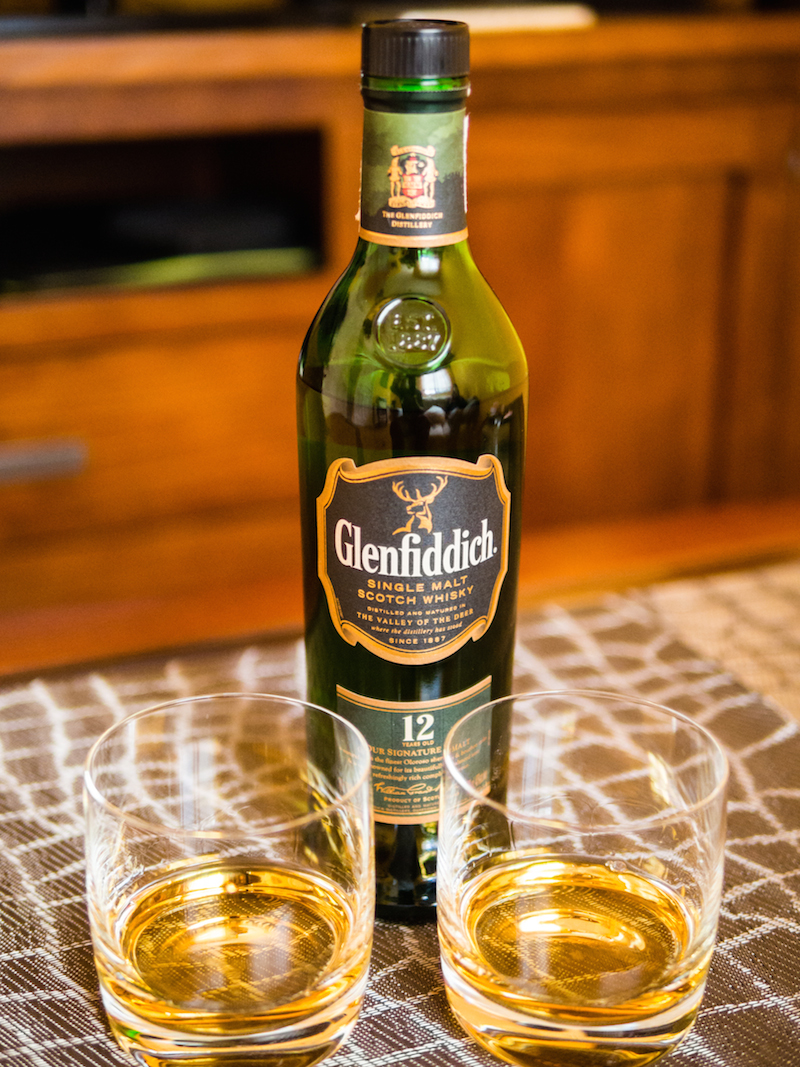
-
With the notable exception of single cask Scotch whiskies, which are single malts made exclusively from a single oak cask. Each single cask bottling is therefore completely unique in its properties. These, however, are fairly rare and not comparable to the rest.↩
-
Again, with the exception of single cask Scotch whiskies.↩
-
Sources: Simply Scotches, Chicago Tribune, Wikipedia.↩
